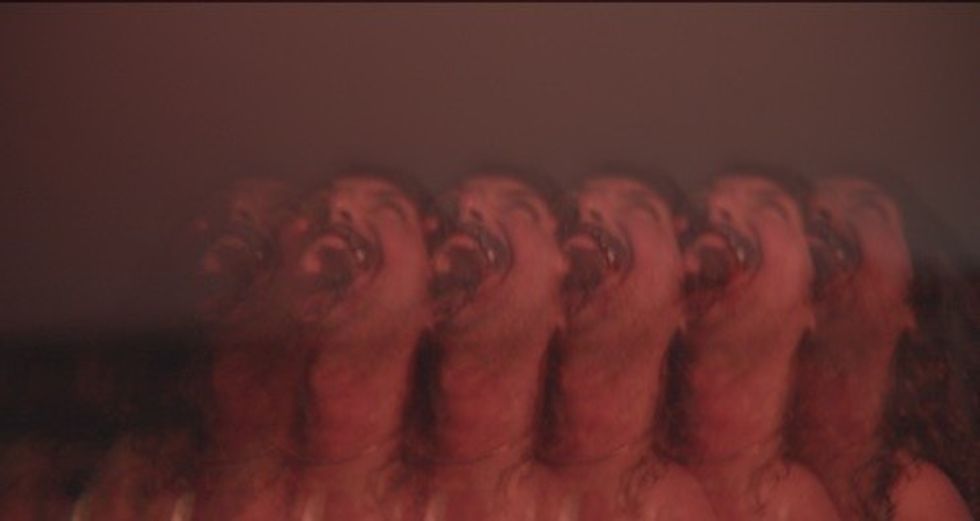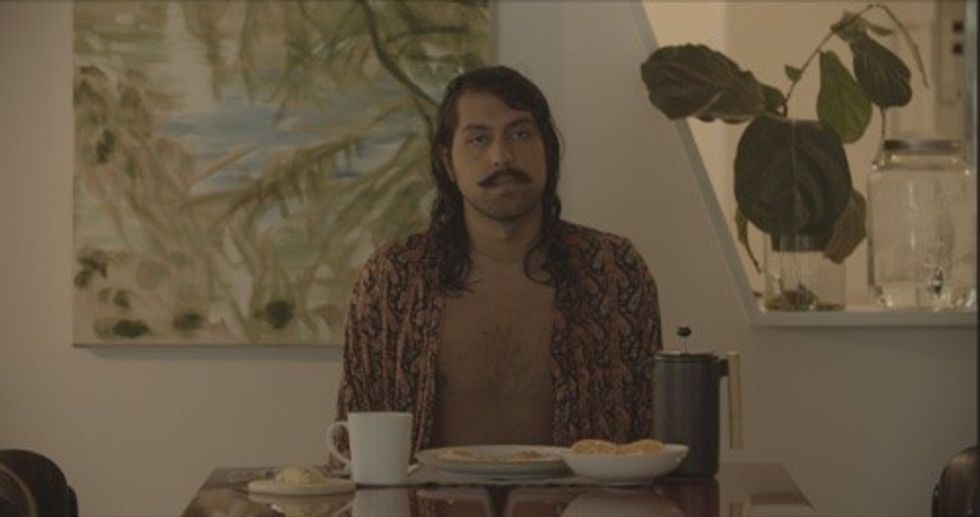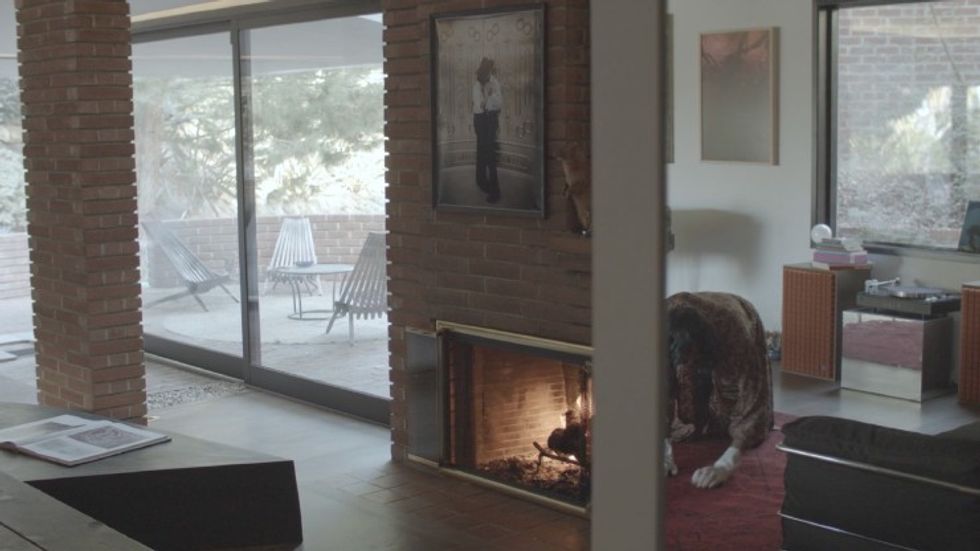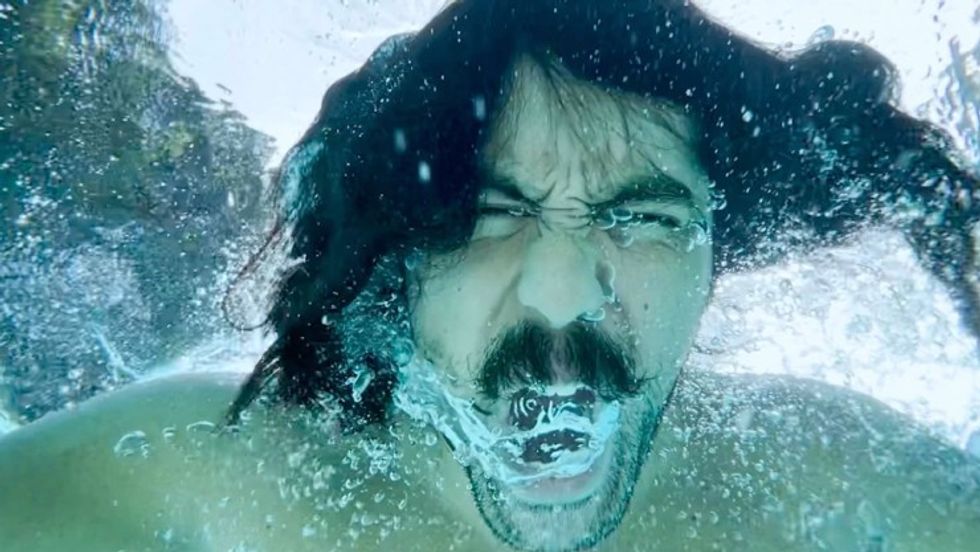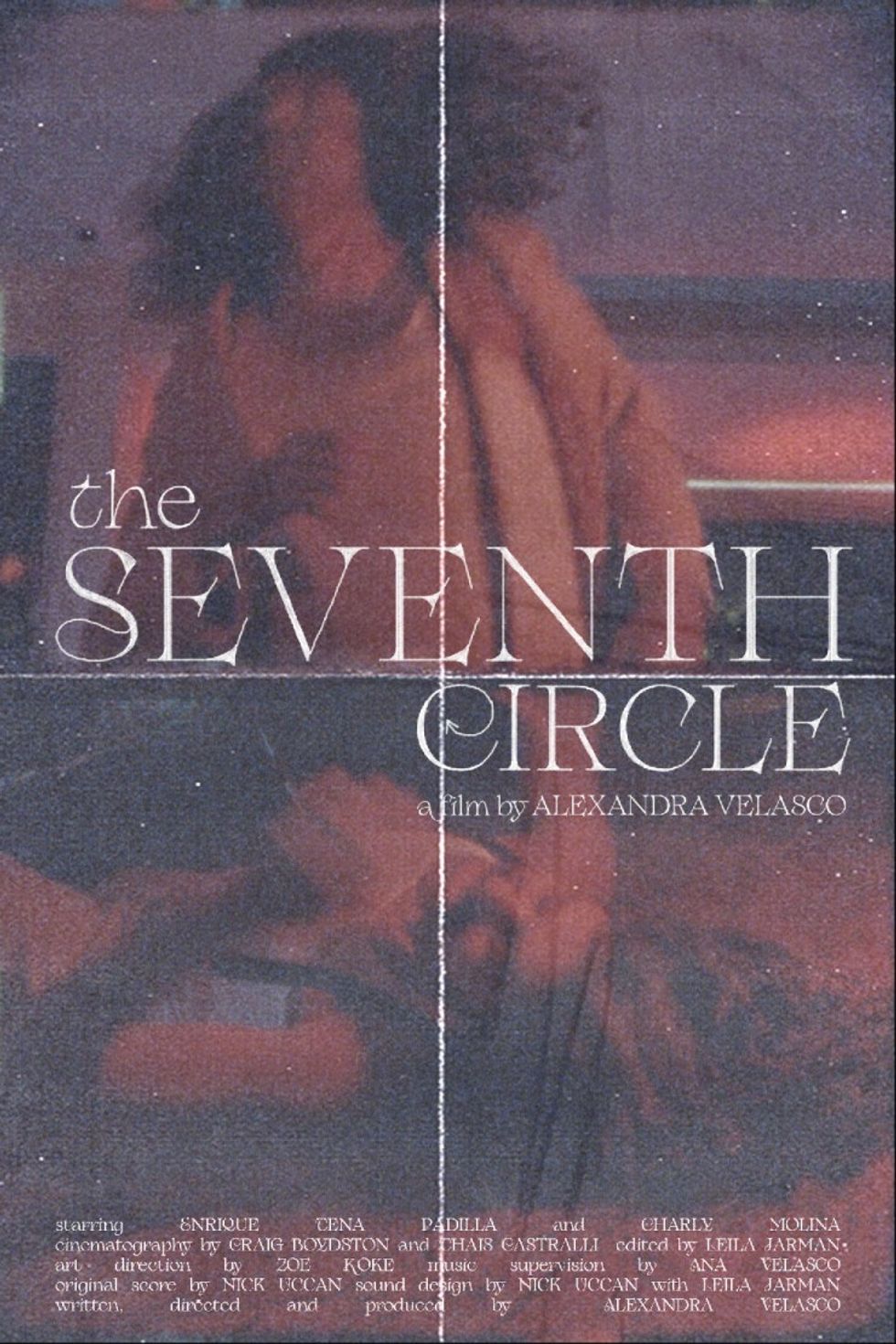How Being Trapped in an Actual Haunted House Inspired This Psychological Horror Short
What happens when you spend lockdown with a ghost in the Hollywood Hills?
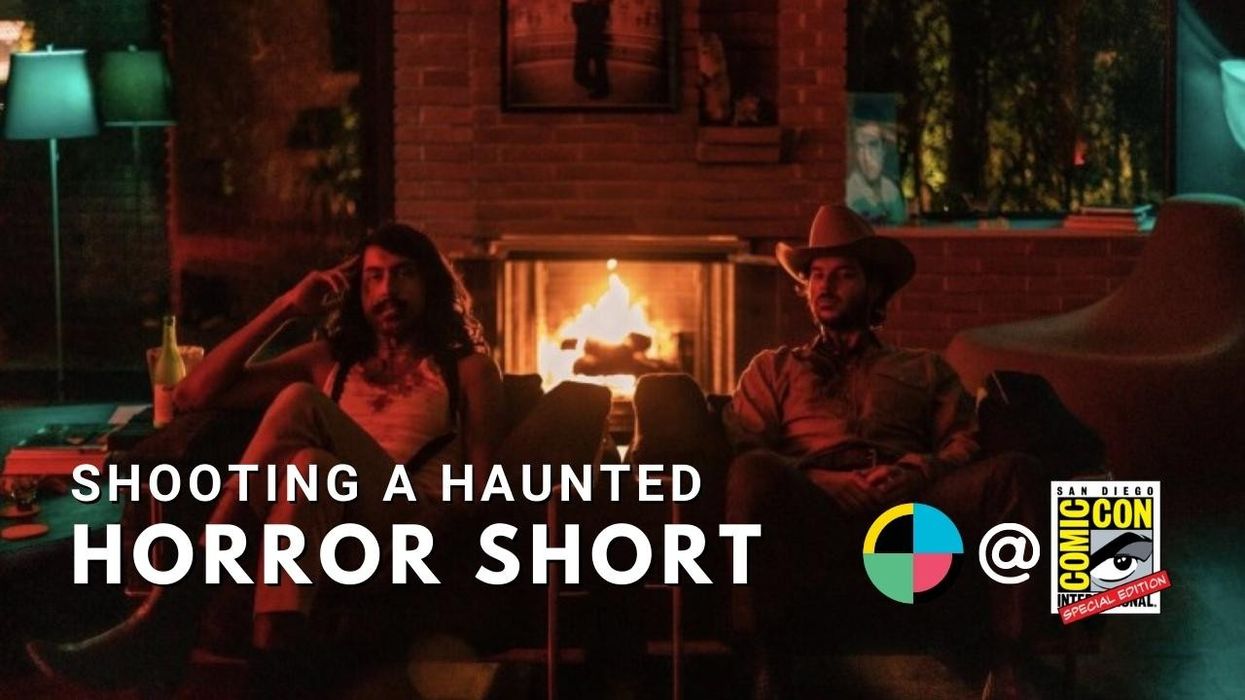
No, it’s not hell, it’s the Baxter-Hodiak house. You know, where the ghost of 1940s-era MGM party-boy John Hodiak roams the premises? Now imagine you can't leave. All you’ve got is some Super 8 film, an iPhone, and a Blackmagic Pocket 6K.
For director Alexandra Velasco (who was stuck in the haunted house) and DP Thaïs Castralli (who was sent back to Brazil in immigration purgatory), navigating this pandemic as immigrant women was almost psychological horror in itself. Here’s how they channeled that into a short film rooted in imagination and experimenting with the rules of filmmaking, called The Seventh Circle.
No Film School: Where did you get the idea to make The Seventh Circle?
Alexandra Velasco: The film revolves around a man who wanders around a beautiful house in a sort of anxious stupor that gets increasingly more aggressive until his friend shows up and our guy’s violent tendencies erupt in an ecstatic dance + murder scene. We are left asking, was this all in his head? Or was it real?
I was lucky enough to spend lockdown with a very close-knit group of friends who were staying at the Baxter-Hodiak house in the Hollywood Hills, where the film was shot. A friend of ours let them live there while he spent the pandemic elsewhere, and it became my second home for that year. The house is incredible, the architecture (designed by famed architect Lautner) and space itself was awe-inspiring, but there is a dark energy to it. Legend says that John Hodiak died in the house and that his ghost currently roams the premises at night. Apparently he had a knack for partying and he shows up when people are immersed in nighttime festivities. I spent New Year's Eve there, and I promise I felt someone touch my shoulder as I danced in the living room. My friend Enrique Cena (who was living there at the time and who is the star of the short film) told me to relax, that John just wanted to party with us; he was harmless. That energy greatly inspired the festive darkness of our film.
During this time our star, Enrique, in addition to being stuck in a house because of COVID-19, also couldn’t leave the country or work or receive unemployment and other benefits because he was in the middle of receiving his O-1 visa, making him be stuck in a country without being able to fend for himself. His frustration grew the more he waited, and waited, and waited. Unable to get answers or to do anything other than leave his fate in the hands of people he didn’t know.
As fellow immigrants we wanted to help him channel those frustrations, so we created this film. A film where he could release his animal side and hopefully release the helplessness and anxiety he was feeling. It was a cathartic experience for everyone, but for him especially.
NFS: Why did you decide to shoot on the Blackmagic Pocket 6? What lenses did you pair it with for this film?
Thaïs Castralli: We had time, budget, and crew limitations, but did not want to compromise on the quality of the look of the film. We had to light and shoot the whole short in one day among ourselves, and move quickly—going from sticks to handheld and gimbal.
Therefore our choice was for a lightweight, compact camera. We were also shooting Super 8 for selected scenes for a specific visual approach. We did not want to bargain with that—we wanted the Super 8 and prepared for that expense. So we picked a camera for the overall shoot that offered us the best cost benefit: the opportunity to move quickly (doing multiple set-ups per hour) while shooting RAW.
The RAW on the Blackmagic allowed us to be economical while not sacrificing quality, and finally, gave us the ability to work with the footage in post in order to match different formats. We used a speedbooster to take advantage of Canon L-series lenses we own.
NFS: Can you talk to us about the process coming up with the shots in the film? How did you create this feeling for the film, and why?
Velasco: When I write, I write already thinking of the shots I want. This film was created in an interesting non-linear manner since it was written with the location in mind first, and I created a story that fit around said location. When I was writing I was imagining where specifically in the house I would want these actions to take place.
Thaïs, Craig, and I did a tech scout, which was basically an architectural tour of the house, and we all imagined and discussed camera placements. Bottom line is, we were in love with the space, and we wanted to take full advantage of every nook and crevice. Especially because the house is being remodeled right now, so the way we see it in the film is a way that will never be seen again. It was our own love letter to the Baxter-Hodiak house.
NFS: When filmmakers think of “arthouse horror” they might think of cinema with a specific 1970s 16mm film look, with slow zooms or non-linear editing, to name a few. We noticed a lot of experimentation with those kinds of elements in The Seventh Circle.
Castralli: I agree with you. From the first conversation I noticed Alexandra’s ideas had roots in that narrative style. I believe the label “arthouse horror” has been used for movies that have borrowed heavily from surrealism as well. Her references made me think of Maya Deren’s Meshes of the Afternoon and a lot of [Luis] Buñuel. I don’t think I’ve ever clearly mentioned it to her, but the theme and representation choices reminded me of The Exterminating Angel.
Mostly, however, her project led me to Polanski’s apartment trilogy as a visual reference. I believe this is the best example for the stylistic choices you mention here. I remember mentioning Repulsion (1966), Rosemary’s Baby (1968), and The Tenant (1976) when we discussed the visual approach. I was interested in the manner by which Polanski traps the viewer inside the claustrophobic environments he creates for his protagonists in those movies. He does so by connecting the audience to the character’s mindset by always telling the story through their perspective and employing multiple close ups (in which the viewer is actually close or sharing the protagonists’ head spaces).
NFS: What did it take to shoot underwater for the pool shots?
Castralli: We actually shot the underwater scene with an iPhone. It was more appealing to us to shoot on a different medium that was set up for it, rather than spending the time/money to prepare an underwater housing.
From the beginning, we were prepared to use each medium according to their potential, taking advantage of the features they had to offer: the flexibility and resolution of the Blackmagic, the practicality of the iPhone, and the specific look of the Super 8.
I believe that limitations give you creative freedom: the budget, time and crew restraints end up focusing our attention on what mattered, the story. Selecting the tools that could best serve us in this challenge meant freeing up time to discuss creative choice.
NFS: You are both women filmmakers commanding your roles as director and DP. Alexandra, you came to LA from Mexico, and Thaïs, you came to LA from Brazil. What would you say have been the big barriers for you to get where you are in filmmaking, and how did you overcome it?
Velasco: I always expressed interest in cinema, an interest that bordered on obsession, even. Nevertheless, I never really got encouraged to pursue filmmaking as a career; it wasn’t even a conversation that was had. To me filmmaking was unattainable, it was something other people did, not I. Even if it was a desire that was burning inside me.
I think overcoming the idea that a girl from Mexico City with no connections in the film industry could never become a filmmaker was the biggest hurdle for me personally. When I moved to Los Angeles, a big hurdle was my immigration status, I think it is the same case for Thaïs. You can't really pursue your dream safely and without anxiety without spending money and time and energy convincing others that they should let you pursue said dream. Now that we both have our green cards, it’s been so creatively freeing, I can't even express it into words. But it really has been an arduous road.
Castralli: Filmmaking in Brazil was a challenge that required filmmakers to be extremely resourceful. The lack of a mature and established film industry, compounded with a deep-seated culture of sexism, provided particular obstacles that made it almost impossible to collaborate in meaningful narratives and develop a career out of it.
I was inspired by a pioneer Brazilian DP: Fernanda Tanaka, ABC. She said, “The less women behind the camera, the more sexist stereotypes appear in front of it. If there is no woman to defend an appropriate female representation, it is expected for it to be formed through a sexist narrative.”
Fernanda’s statement showed me that my sheer presence on set—that I found so insignificant—could help transform the work environment. Untold stories would only come from a new workforce. Moving to Los Angeles allowed me to meet artists who were interested in collaborating rather than excluding, and presented me with possibilities to develop relevant creations, to represent unique narratives.
I should note: I state this based on my experience prior to moving to Los Angeles. I did not experience the change I’m aware that has been happening in the country’s filmmaking scenery. I know multiple talented women who are being hired more often and respected on set, showing productions are taking a more inclusive approach. As commendable as the change of practices we’re witnessing in the filmmaking landscape in multiple countries, let’s not lose sight of the major efforts that go into a daily fight for representation in the arts and how late in the game it’s coming to light. Brazil is historically a country where the expression of “machismo” is absorbed in the private sphere and infused into the public one)
NFS: Do you both have any advice for other filmmakers?
Velasco: Don’t be afraid to share your ideas with friends, you never know who’s gonna bite and will help you create some magic! Also don’t let the financial aspect of it all stop you, make something with your phone if you have to. It’s all about telling the story, and playing around!
Castralli: Alexandra’s words inspire and sum up the encouragement I would like to share with any filmmakers who are struggling to keep on that path right now. This is a labor of love. We give so much of ourselves to it. It takes time, hard work, commitment, and unconditional passion for the job. DP Eric Steelberg once said something while remembering his career that stayed with me: “Fail to prepare, prepare to fail.” Be prepared. Keep creating, keep looking for collaborators you would like to develop a creation with. Keep studying, stay updated with your craft. Keep inspiring yourself. Watch as many movies as you can, look for the ones you wouldn’t usually watch, consume art—build your own collection of references, your own personal “mind library of references.”
Keep an eye out for The Seventh Circle, which moves to more stops on the festival circuit throughout the next year.
